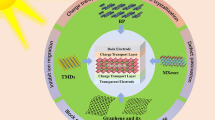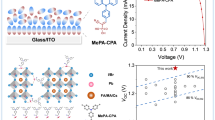Abstract
Organic solar cells based on P3HT:PCBM bulk heterojunction were prepared and subjected to post annealing at different temperatures (100, 120, 140, 160 and 180 °C). SEM, AFM as well as optical images have revealed that post deposition heat treatment has induced significant phase segregation between P3HT and PCBM which were found to result in growth of PCBM clusters on the films surface. The P3HT:PCBM absorption spectra were found to be blue shifted by 7 nm in films subjected to heat treatment at 160 °C and 180 °C. XRD data show a single diffraction peak at 2θ = 5.33 ± 0.23o for P3HT:PCBM films and was attributed to the edge-on arrangement of the (100) plane. Space charge limited conduction theory was employed to determine the charge carrier mobility; the highest obtained mobility was obtained for devices with active layers heat-treated at 140 °C. The change in the barrier height was derived from dark I–V. The variation in the metal–semiconductor contact between the Al electrode and P3HT:PCBM active layer were addressed and the barrier height has increased to form hole blocking contact and the ideality factor has decreased implying a decrease in the recombination rate. A direct relation between Fermi level, Vbi, and Voc was studied. Efficient device performance was ascribed to P3HT:PCBM layers which were subjected to post deposition heat treatment at 140 °C with PCE = 5.5 %, FF = 65.6 %, Jsc = 12.9 mA cm−2 and Voc = 0.65 V.











Similar content being viewed by others
References
H.-L. Huang, C.-T. Lee, H.-Y. Lee, Performance improvement mechanisms of P3HT: PCBM inverted polymer solar cells using extra PCBM and extra P3HT interfacial layers. Org. Electron. 21, 126–131 (2015)
T. Kirchartz, W. Gong, S.A. Hawks, T. Agostinelli, R.C. MacKenzie, Y. Yang, J. Nelson, Sensitivity of the Mott–Schottky Analysis in Organic Solar Cells. J. Phys. Chem. C116, 7672–7680 (2012)
M.S. Ryu, J.C. Hyuk, J. Jin, Effects of thermal annealing of polymer: fullerene photovoltaic solar cells for high efficiency. Curr. Appl. Phys. 10(2), S206–S209 (2010)
A.J. Moulé, K. Meerholz, Controlling morphology in polymer–fullerene mixtures. Adv. Mater. 20(2), 240–245 (2008)
K. Kim et al., Roles of donor and acceptor nano-domains in 6% efficient thermally annealed polymer photovoltaics. Appl. Phys. Lett. 90(16), 163511 (2007)
B. Kadem, W. Cranton, A. Hassan, Metal salt modified PEDOT: PSS as anode buffer layer and its effect on power conversion efficiency of organic solar cells. Org. Electron. 24, 73–79 (2015)
V.D. Mihailetchi, H.X. Xie, B. de Boer, L.J.A. Koster, P.W.M. Blom, Charge transport and photocurrent generation in poly (3-hexylthiophene): methanofullerene bulk-heterojunction solar cells. Adv. Funct. Mater. 16, 699–708 (2006)
J. Hwang, A. Wan, A. Kahn, Energetics of metal–organic interfaces: New experiments and assessment of the field. Mater. Sci. Eng. R 64, 1–31 (2009)
S.M. Sze, K.K. Ng, Physics of semiconductor devices (Wiley, New York, 2007)
O. Oklobia, T.S. Shafai, A quantitative study of the formation of PCBM clusters upon thermal annealing of P3HT/PCBM bulk heterojunction solar cell. Sol. Energy Mater. Sol. Cells 117, 1–8 (2013)
F. Padinger, R.S. Rittberger, N.S. Sariciftci, Effects of postproduction treatment on plastic solar cells. Adv. Funct. Mater. 13(1), 85–88 (2003)
G.T. Yue, J.H. Wu, Y.M. Xiao, H.F. Ye, J.M. Lin, M.L. Huang, Flexible dye-sensitized solar cell based on PCBM/P3HT hetrojunction. Chin. Sci. Bull. 56(3), 325–330 (2011)
P.J. Brown, D.S. Thomas, A. Kohler, J.S. Wilson, J.S. Kim, C.M. Ramsdale, H. Sirringhaus, R.H. Friend, Effect of interchain interactions on the absorption and emission of poly.3-hexylthiophene. Phys. Rev. B 67, 064203 (2013)
M. Manceau et al., Effects of long-term UV–visible light irradiation in the absence of oxygen on P3HT and P3HT: PCBM blend. Sol. Energy Mater. Sol. Cells 94(10), 1572–1577 (2010)
R. Ramani, S. Alam, A comparative study on the influence of alkyl thiols on the structural transformations in P3HT/PCBM and P3OT/PCBM blends. Polymer 54(25), 6785–6792 (2013)
T. Erb, U. Zhokhavets, H. Hoppe, G. Gobsch, M. Al-Ibrahim, O. Ambacher, Thinsolid films, absorption and crystallinity of poly(3-hexylthiophene)/fullerene blends in dependence on annealing temperature. Thin Solid Films 511, 483–485 (2006)
M. Al-Ibrahim, O. Ambacher, Effects of solvent and annealing on the improved performance of solar cells based on poly.3-hexylthiophene: fullerene. Appl. Phys. Lett. 86, 201120 (2005)
Y. Sun, J.-g. Liu, Y. Ding, Y.-c. Han, Controlling the surface composition of P3HT/PCBM blend films by using miced solvents with different evaporation rates. Chin. J. Polym. Sci. 31(7), 1029–1037 (2013)
Y.S. Kim, Y. Lee, J.K. Kim, E.O. Seo, E.W. Lee, W. Lee, S.H. Han, S.H. Lee, Effect of solvents on the performance and morphology of polymer photovoltaic devices. Curr. Appl. Phys. 10, 985–989 (2010)
S.-Y. Chuang, H.-L. Chen, W.-H. Lee, Y.-C. Huang, S. Wei-Fang, W.-M. Jen, C.-W. Chen, Regioregularity effects in the chain orientation and optical anisotropy of composite polymer/fullerene films for high-efficiency, large-area organic solar cells. J. Mater. Chem. 19, 5554–5560 (2009)
U. Zhokhavets, T. Erb, H. Hoppe, G. Gobsch, N.S. Sariciftci, Effect of annealing of poly (3-hexylthiophene)/fullerene bulk heterojunction composites on structural and optical properties. Thin Solid Films 496, 679–682 (2006)
F. Reisdorffer, O. Haas, P. Le Rendu, T.P. Nguyen, Co-solvent effects on the morphology of P3HT:PCBM thin films. Synth. Met. 161, 2544–2548 (2012)
H. Zhang, X. Meifeng, R. Cui, X. Guo, S. Yang, L. Liao, Yu. Quanjie Jia, J.D. Chen, B. Sun, Enhanced performance of inverted organic photovoltaic cells using CNTs–TiOX nanocomposites as electron injection layer. Nanotechnology 24, 355401 (2013)
A. Swinnen, I. Haeldermans, M. vande Ven, J. D’Haen, G. Vanhoyland, S. Aresu, M. D’Olieslaeger, J. Manca, Tuning the Dimensions of C60-Based Needlelike Crystals in Blended Thin Films. Adv. Funct. Mater. 16, 760–765 (2006)
B. Watts, W.J. Belcher, L. Thomsen, H. Ade, P.C. Dastoor, A quantitative study of PCBM diffusion during annealing of P3HT: PCBM blend films. Macromolecules 42(21), 8392–8397 (2009)
J.U. Lee, J.W. Jung, T. Emrick, T.P. Russell, W.H. Jo, Morphology control of a Polythiophene-fullerene bulk heterojunction for enhancement of the high-temperature stability of solar cell performance by a new donor–acceptor diblock copolymer. Nanotechnology 21, 105201 (2010)
W. Ma, C. Yang, X. Gong, K. Lee, A.J. Heeger, Thermally stable, efficient polymer solar cells with nanoscale control of the interpenetrating network morphology. Adv. Funct. Mater. 15, 1617–1622 (2005)
E.A. Parlak, The blend ratio effect on the photovoltaic performance and stability of poly (3-hexylthiophene):[6, 6]-phenyl-C61 butyric acid methyl ester (PCBM) and poly(3-octylthiophene):PCBM solar cells. Sol. Energy Mater. Sol. Cells 100, 174–184 (2012)
I. Etxebarria, J. Ajuria, R. Pacios, Solution-processable polymeric solar cells: a review on materials, strategies and cell architectures to overcome 10%. Org. Electron. 19, 34–60 (2015)
Y. Lu et al., Temperature-dependent morphology evolution of P3HT: PCBM blend solar cells during annealing processes. Synth. Met. 162(23), 2039–2046 (2012)
B.Y. Kadem, A.K. Hassan, W. Cranton, Enhancement of power conversion efficiency of P3HT: PCBM solar cell using solution processed Alq3 film as electron transport layer. J. Mater. Sci. Mater. Electron. 26(6), 3976–3983 (2015)
B. Gunduz, I.S. Yahia, F. Yakuphanoglu, Electrical and photoconductivity properties of p-Si/P3HT/Al and p-Si/P3HT:MEH-PPV/Al organic devices: comparison study. Microelectron. Eng. 98, 41–57 (2012)
M.M. El-Nahass, K.F. Abd, El-Rahman, nickel phthalocyanine thin films. J. Alloys Compd. 430, 194–199 (2007)
D.H. Apaydin, D.E. Yildiz, A. Cirpan, L. Toppare, Optimizing the organic solar cell efficiency: role of the active layer thickness. Sol. Energy Mater. Sol. Cells 113, 100–105 (2013)
B. Qi, Q. Zhou, J. Wang, Exploring the open-circuit voltage of organic solar cells under low temperature. Sci. Rep. 5, 11363 (2015)
Y. Shen, K. Li, N. Majumdar, J.C. Campbell, M.C. Gupta, Bulk and contact resistance in P3HT:PCBM heterojunction solar cells. Sol. Energy Mater. Sol. Cells 95, 2314–2317 (2011)
O. Oklobia, T.S. Shafai, Correlation between charge carriers mobility and nanomorphology in a blend ofP3HT/PCBM bulk heterojunction solar cell: impact on recombination mechanisms. Sol. Energy Mater. Sol. Cells 122, 158–163 (2014)
B. Kadem, A. Hassan, W. Cranton, Performance optimization of P3HT:PCBM solar cells by controlling active layer thickness, Proceedings of the 31st European photovoltaic solar energy conference and exhibition, EUPVSEC (2015, Hamburg, Germany)
P.R. Somani, S.P. Somani, M. Umeno, Toward organic thick film solar cells: three dimensional bulk heterojunction organic thick film solar cell using fullerene single crystal nanorods. Appl. Phys. Lett. 91, 173503 (2007)
M.-S. Kim, B.-G. Kim, J. Kim, Effective Variables To Control the Fill Factor of Organic Photovoltaic Cells. ACS. Appl. Mater. Interfaces 1, 1264 (2009)
T.-Y. Chu, O.-K. Song, Hole mobility of N, N′ -bis-naphthalen-1-yl)-N, N′ -bis(phenyl)-benzidine investigated by using space-charge-limited currents. Appl. Phys. Lett. 90, 203512 (2007)
Ö. Güllü, Ş. Aydoğan, A. Türüt, High barrier Schottky diode with organic interlayer. Solid State Commun. 152(5), 381–385 (2012)
C. Liu, X. Yong, Y.-Y. Noh, Contact engineering in organic field-effect transistors. Mater. Today 18(2), 79–96 (2015)
Y. Lou et al., Charge transport characteristics in P3HT:PCBM organic blends under illumination: Influence of metal work functions. Chem. Phys. Lett. 529, 64–68 (2012)
V. Shrotriya, Y. Yang, Capacitance-voltage characterization of polymer light-emitting diodes. J. Appl. Phys. 97, 054504 (2005)
N. Simsir, H. Safak, Ö.F. Yüksel, M. Kus, Investigation of current voltage and capacitance voltage characteristics of Ag/perylene -monoimide/n-GaAs Schottky diode. Curr. Appl. Phys. 12, 1510–1514 (2012)
C.-H. Ruan, Y.-J. Lin, High Schottky barrier height of Au contact on Si-nanowire arrays with sulfide treatment. J. Appl. Phys. 114, 143710 (2013)
Z. Khurelbaatar, K.H. Shim, J. Cho, H. Hong, V.R. Reddy, C.J. Choi, Temperature dependent current–voltage and capacitance–voltage characteristics of an Au/n-type Si Schottky Barrier diode modified using a PEDOT:PSS interlayer. Mater. Trans. 56(1), 10–16 (2015)
H. Li, Z.G. Zhang, Y. Li, J. Wang, Tunable open-circuit voltage in ternary organic solar cells. Appl. Phys. Lett. 101, 163302 (2012)
D. Gupta, S. Mukhopadhyay, K.S. Narayan, Fill factor in organic solar cells. Solar Energy Mater Solar Cells 94, 1309–1313 (2010)
X. Yang, A. Uddin, Effect of thermal annealing on P3HT: PCBM bulk-heterojunction organic solar cells: a critical review. Renew. Sustain. Energy Rev. 30, 324–336 (2014)
Acknowledgments
The authors would like to acknowledge the sponsorship from Iraq Ministry of Higher Education and Scientific Research, Faculty of Science of Babylon University, Iraq and Mathew Kitchen from Material and Engineering Research Institute (MERI) at Sheffield Hallam University, UK for his assistance in optical imaging.
Author information
Authors and Affiliations
Corresponding author
Rights and permissions
About this article
Cite this article
Kadem, B., Hassan, A. & Cranton, W. Efficient P3HT:PCBM bulk heterojunction organic solar cells; effect of post deposition thermal treatment. J Mater Sci: Mater Electron 27, 7038–7048 (2016). https://doi.org/10.1007/s10854-016-4661-8
Received:
Accepted:
Published:
Issue Date:
DOI: https://doi.org/10.1007/s10854-016-4661-8




